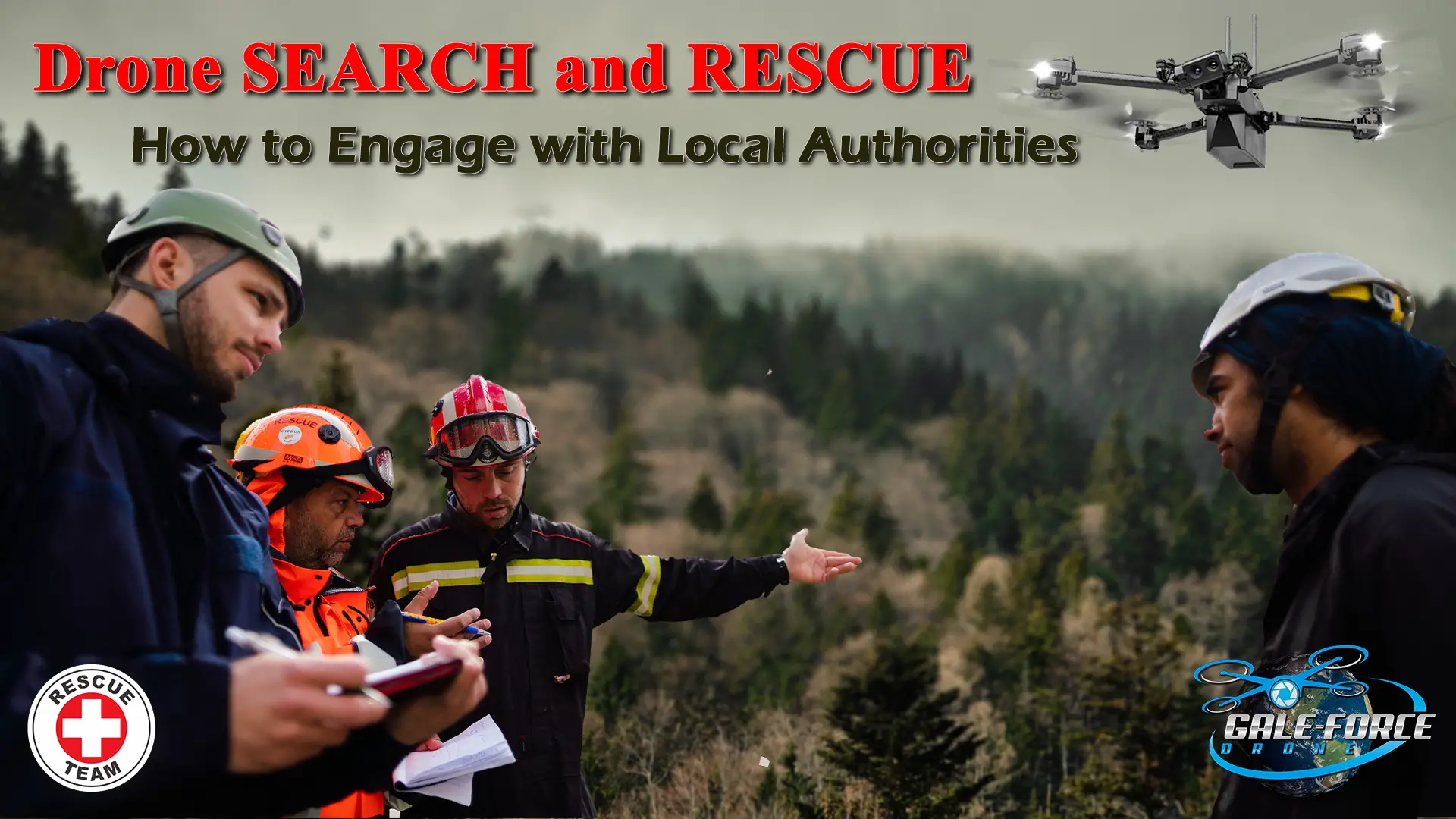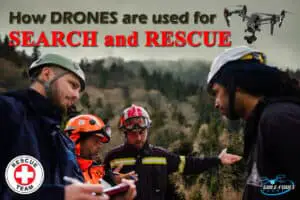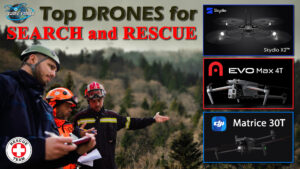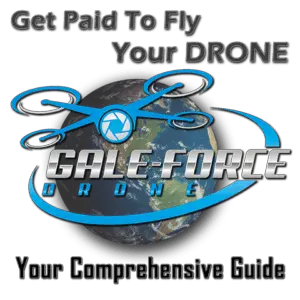

Emergencies are never predictable, are always unique and can occur with no warning. However, emergency response teams MUST have standardized procedures in order to ensure that resources are deployed in a structured and organized manner. This is why it is so important to research and understand your local regulations and procedures before offering your drone assistance in search and rescue operations.
I remember the first time, after I had purchased my Phantom 4, we had a tornado come through our area. I immediately wondered if or how I might be able to offer assistance to local authorities.
For SAR (search and rescue) operations, you will need to research and familiarize yourself with the local regulations and procedures. Different jurisdictions have different requirements for drone operations, and some may require special permits or certifications as well as specific protocols for how drones are used in emergency situations. Additionally, it is important to know how local emergency response teams and government agencies handle emergencies and what their protocols are for drone use.
Not taking the time to research and understand these regulations and procedures can actually hinder the search and rescue operation and may result in legal consequences for getting involved improperly. For example, failing to obtain the necessary permission or authorization could result in fines or legal action, and even damage your reputation in the community. In addition, not following local protocols for drone use during emergency situations could interfere with ongoing rescue efforts and potentially endanger lives.
If you are serious about getting into SAR, do your due diligence and thoroughly research the local regulations and procedures before offering drone assistance in search and rescue operations. This will ensure that you are compliant and effective in any operation, while also avoiding any potential legal issues or hindrances to the rescue process.
 Click into this article “How DRONES are used for SEARCH and RESCUE” to learn about how you can help your local ERT’s by using your drone for search and rescue and first response operations.
Click into this article “How DRONES are used for SEARCH and RESCUE” to learn about how you can help your local ERT’s by using your drone for search and rescue and first response operations.

Emergencies can happen in the blink of an eye, and as a drone pilot, it is natural to want to find a way to help out. However, we need to first properly engage with our local emergency response teams, such as the sheriff, fire department, or other first responders. When making contact, it is essential to communicate clearly about yours and your drone’s capabilities and limitations, and highlight how you can be of assistance in search and rescue operations.
The initial contact with emergency response teams is crucial to building trust and establishing a good working relationship. Approach the situation professionally and provide relevant information about your experience and equipment. By establishing a clear understanding of your role and the procedures involved, you will earn the respect of the ERT’s by already knowing the local regulations, giving the agencies assurance that you are a worthy and effective resource, and fully compliant with the use of your drone in search and rescue operations.

To join and engage in a search and rescue operation as a drone pilot, you may need to contact the following local government agencies:
Emergency Management Office: This office is responsible for managing emergency operations, including search and rescue missions.
Fire Department: The fire department is often involved in search and rescue operations and may be the first point of contact for drone pilots.
Law Enforcement: Local law enforcement agencies may be involved in search and rescue operations, especially in cases of missing persons.
Parks and Wildlife Department: This department may be involved in search and rescue operations in outdoor areas such as parks, forests, and wilderness areas.
Department of Transportation: This department may be responsible for coordinating search and rescue operations that involve transportation infrastructure such as highways, bridges, and airports.
National Guard: In some cases, the National Guard may be involved in search and rescue operations, especially in disaster response situations.
The various agencies, emergency response teams and first responders involved in search and rescue operations may vary depending on the location and type of operation. It’s best to check with local authorities for the most up-to-date information on how to get involved as a drone pilot in a search and rescue mission.
I personally suggest taking the initiative, in advance of an emergency to reach out to these agencies in your area to establish yourself as a go-to Drone resource.

The specific documentation required will certainly vary depending on the location and agency involved, but generally, a drone pilot seeking approval to perform search and rescue missions may need to provide the following documents:
Remote pilot certificate – This is your Part 107 certification issued by the Federal Aviation Administration (FAA) after passing the knowledge test.
Drone registration – Drones must be registered with the FAA before they can be flown for commercial purposes.
Proof of insurance – Drone pilots may need to show proof of liability insurance coverage.
Authorization for Restricted Airspace flight – Depending on the location of the search and rescue operation, the drone pilot may need to obtain authorization from the FAA or other aviation authorities to use the airspace.
Mission plan – A detailed mission plan from the government agency that outlines the scope of the search and rescue operation, including flight paths, altitudes, and any areas that need to be avoided.
Emergency procedures plan – A plan that outlines your emergency procedures in case of a drone malfunction, lost communication, or other unforeseen circumstances.
Authorization from local authorities – The drone pilot may need to obtain authorization from local law enforcement or emergency services agencies before engaging in search and rescue operations.
The process(es) for the required documentation and approvals will vary depending on the location and agency involved, so as I have previously recommended, it is better to contact the various government agencies in advance to understand their requirements.

Below is a general list of the proper protocols and procedures that should be considered when engaging with local government agencies:
Identify the relevant agency: The first step is to identify the local government agency that handles the type of assistance you are interested in working with. This could include emergency services, law enforcement, environmental agencies, or others.
Contact the agency: Once you have identified the relevant agency, reach out to them through their official channels. This could include phone, email, or their website. Be clear and concise about what you are offering and provide any relevant details about your capabilities.
Provide necessary information: When contacting the agency, provide all necessary information about yourself, as well as any other relevant details that will help with aligning you and your offering with the agency .
Follow up: After contacting the agency, be sure to follow up regularly to ensure that you remain available to assist when needed. Be prepared to provide any additional information that may be required.
Follow agency guidelines: When engaging with local government agencies, it’s important to follow their guidelines and procedures. Be respectful of their authority and be sure to comply with any requests or directives they may give.
Document everything: Keep detailed records of all communications with the agency, including the names of individuals you spoke with, the dates and times of the conversations, and any information provided. This will help you stay organized and provide a record of your efforts if needed.
Express gratitude: It is good to always express your appreciation to the agency and any individuals you have worked with. This can help build positive relationships with local government agencies and encourage future cooperation.
Remember, government agencies will have a lot of bureaucracy and policy involved with these processes. Be patient, follow up and say thank you.
 Click into my article “Top Drones for Search and Rescue Operations” where I describe some of the drones that are well-suited for drone search and rescue operations.
Click into my article “Top Drones for Search and Rescue Operations” where I describe some of the drones that are well-suited for drone search and rescue operations.

Whether you are a brand new drone pilot, or a veteran pilot interested in working in search and rescue, you must understand the importance of communication and follow the procedures outlined in this guide. By doing so, you can feel confident that your drone operations are legal, SAFE and ultimately successful in finding those who need assistance.
Imagine that you have joined with a search and rescue operation in a rural area. You fly your drone without informing the local emergency response teams and government agencies, believing that you’re helping in the search effort. However, due to a lack of proper engagement and communication, your activities are seen as unauthorized surveillance, and the authorities on the ground perceive you to be a threat to the mission.
In response, the local authorities quickly escalate the situation, mobilizing a law enforcement response to find you, grounding your drone, which could have been an essential tool for finding a missing person. The search and rescue mission is delayed, the public trust is broken, and the drone pilot’s credibility is tarnished.
This scenario illustrates the importance of effective engagement between drone pilots and the local emergency response teams and government agencies. By failing to engage properly, the drone pilot caused unnecessary panic and disrupted the search and rescue mission, instead of aiding it.
With proper engagement, you will establish yourself as a trusted drone resource and valued part of the local teams.

